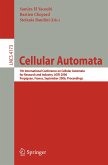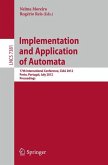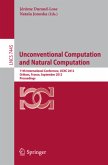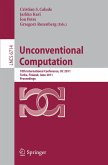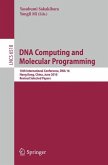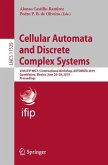Cellular Automata
8th International Conference on Cellular Automata for Research and Industry, ACRI 2008, Yokohama, Japan, September 23-26, 2008, Proceedings
Herausgegeben:Umeo, Hiroshi; Morishita, Shin; Nishinari, Katsuhiro; Komatsuzaki, Toshihiko
Cellular Automata
8th International Conference on Cellular Automata for Research and Industry, ACRI 2008, Yokohama, Japan, September 23-26, 2008, Proceedings
Herausgegeben:Umeo, Hiroshi; Morishita, Shin; Nishinari, Katsuhiro; Komatsuzaki, Toshihiko
- Broschiertes Buch
- Merkliste
- Auf die Merkliste
- Bewerten Bewerten
- Teilen
- Produkt teilen
- Produkterinnerung
- Produkterinnerung
This book constitutes the refereed proceedings of the 8th International Conference on Cellular Automata for Research and Industry, ACRI 2008, held in Yokohama, Japan, in September 2008.
The 43 revised full papers and 22 revised poster papers presented together with 4 invited lectures were carefully reviewed and selected from 78 submissions. The papers focus on challenging problems and new research not only in theoretical but application aspects of cellular automata, including cellular automata tools and computational sciences. The volume also contains 11 extended abstracts dealing with…mehr
Andere Kunden interessierten sich auch für
![Cellular Automata Cellular Automata]() Samira El Yacoubi / Bastien Chopard / Stafania Bandini (eds.)Cellular Automata78,99 €
Samira El Yacoubi / Bastien Chopard / Stafania Bandini (eds.)Cellular Automata78,99 €![Cellular Automata Cellular Automata]() Stefania Bandini / Bastien Chopard / Marco Tomassini (eds.)Cellular Automata38,99 €
Stefania Bandini / Bastien Chopard / Marco Tomassini (eds.)Cellular Automata38,99 €![Implementation and Application of Automata Implementation and Application of Automata]() Implementation and Application of Automata38,99 €
Implementation and Application of Automata38,99 €![Unconventional Computation and Natural Computation Unconventional Computation and Natural Computation]() Unconventional Computation and Natural Computation36,99 €
Unconventional Computation and Natural Computation36,99 €![Unconventional Computation Unconventional Computation]() Unconventional Computation39,99 €
Unconventional Computation39,99 €![DNA Computing and Molecular Programming DNA Computing and Molecular Programming]() DNA Computing and Molecular Programming39,99 €
DNA Computing and Molecular Programming39,99 €![Cellular Automata and Discrete Complex Systems Cellular Automata and Discrete Complex Systems]() Cellular Automata and Discrete Complex Systems38,99 €
Cellular Automata and Discrete Complex Systems38,99 €-
-
-
This book constitutes the refereed proceedings of the 8th International Conference on Cellular Automata for Research and Industry, ACRI 2008, held in Yokohama, Japan, in September 2008.
The 43 revised full papers and 22 revised poster papers presented together with 4 invited lectures were carefully reviewed and selected from 78 submissions. The papers focus on challenging problems and new research not only in theoretical but application aspects of cellular automata, including cellular automata tools and computational sciences. The volume also contains 11 extended abstracts dealing with crowds and cellular automata, which were presented during the workshop C&CA 2008. The papers are organized in topical sections on CA theory and implementation, computational theory, physical modeling, urban, environmental and social modeling, pedestrian and traffic flow modeling, crypto and security, system biology, CA-based hardware, as well as crowds and cellular automata.
Hinweis: Dieser Artikel kann nur an eine deutsche Lieferadresse ausgeliefert werden.
The 43 revised full papers and 22 revised poster papers presented together with 4 invited lectures were carefully reviewed and selected from 78 submissions. The papers focus on challenging problems and new research not only in theoretical but application aspects of cellular automata, including cellular automata tools and computational sciences. The volume also contains 11 extended abstracts dealing with crowds and cellular automata, which were presented during the workshop C&CA 2008. The papers are organized in topical sections on CA theory and implementation, computational theory, physical modeling, urban, environmental and social modeling, pedestrian and traffic flow modeling, crypto and security, system biology, CA-based hardware, as well as crowds and cellular automata.
Hinweis: Dieser Artikel kann nur an eine deutsche Lieferadresse ausgeliefert werden.
Produktdetails
- Produktdetails
- Theoretical Computer Science and General Issues 5191
- Verlag: Springer / Springer Berlin Heidelberg / Springer, Berlin
- Artikelnr. des Verlages: 12447084, 978-3-540-79991-7
- 2008
- Seitenzahl: 596
- Erscheinungstermin: 28. August 2008
- Englisch
- Abmessung: 235mm x 155mm x 32mm
- Gewicht: 889g
- ISBN-13: 9783540799917
- ISBN-10: 3540799915
- Artikelnr.: 24764306
- Herstellerkennzeichnung
- Springer-Verlag GmbH
- Tiergartenstr. 17
- 69121 Heidelberg
- ProductSafety@springernature.com
- Theoretical Computer Science and General Issues 5191
- Verlag: Springer / Springer Berlin Heidelberg / Springer, Berlin
- Artikelnr. des Verlages: 12447084, 978-3-540-79991-7
- 2008
- Seitenzahl: 596
- Erscheinungstermin: 28. August 2008
- Englisch
- Abmessung: 235mm x 155mm x 32mm
- Gewicht: 889g
- ISBN-13: 9783540799917
- ISBN-10: 3540799915
- Artikelnr.: 24764306
- Herstellerkennzeichnung
- Springer-Verlag GmbH
- Tiergartenstr. 17
- 69121 Heidelberg
- ProductSafety@springernature.com
Invited Papers.- From CA to Gene Expression: Machines and Mechanisms.- What's New in Wolfram's New Kind of Science?.- Quantum Walks and Quantum Cellular Automata.- Modelling of Transport and Traffic Problems.- 1: Tools and Theory.- Occurrence of Gliders in an Infinite Class of Life-Like Cellular Automata.- Cellular Automata-Based Structures to Compute the Solutions of Linear Difference Equations.- Computing by Swarm Networks.- On a Membrane Formation in a Spatio-temporally Generalized Prisoner's Dilemma.- An Asynchronous Cellular Automaton Implementing 2-State 2-Input 2-Output Reversed-Twin Reversible Elements.- Game 'Life' with Anticipation Property.- On the Representation of Gliders in Rule 54 by De Bruijn and Cycle Diagrams.- A Cellular Automaton Model for Tribological Problems.- Stabilizing and Destabilizing Effects of Embedding 3-Node Subgraphs on the State Space of Boolean Networks.- About 4-States Solutions to the Firing Squad Synchronization Problem.- Evaluating Cellular Automata Models by Evolutionary Multiobjective Calibration.- Entropy and Chaos in a Lattice Gas Cellular Automata.- Analysis of 90/150 Two Predecessor Nongroup Cellular Automata.- Analysis of Linear Group GF(2 p ) Cellular Automata.- On the Collision-Propagation and Gather-Update Formulations of a Cellular Automata Rule.- Exploring CA State Space to Synthesize Cellular Automata with Specified Attractor Set.- Characterization of Non-reachable States in Irreversible CA State Space.- An Efficient n ×n Boolean Mapping Using Additive Cellular Automata.- Controlling the Dynamics of the Fuzzy Cellular Automaton Rule 90, I..- Examples of Fast and Slow Convergence of 2D Asynchronous Cellular Systems.- Multi-scale Modeling with Cellular Automata: The Complex Automata Approach.- ReconfiguringCircuits Around Defects in Self-Timed Cellular Automata.- Theory of Composing Non-linear Machines with Predictable Cyclic Structures.- Combined Effect of Topology and Synchronism Perturbation on Cellular Automata: Preliminary Results.- Finite Size Stability Analysis for Stochastic Cellular Automata.- On the Addition of Recurrent Configurations of the Sandpile-Model.- A Construction Method of Moore Neighborhood Number-Conserving Cellular Automata.- Changing Neighborhoods of CA: Reduced Local Structures and Embeddings for Universality.- 2: CA Applications.- Error Investigations in Complex Automata Models for Reaction-Diffusion Systems.- Simulation of the Effect of Intermittent Flow in Polycrystals on the Basis of Cellular Automata and Relaxation Element Method.- Lattice Gas Automata Simulation of 2D Site-Percolation Diffusion: Configuration Dependence of the Theoretically Expected Crossover of Diffusion Regime.- Study on Acoustic Field with Fractal Boundary Using Cellular Automata.- The Heart Pacemaker by Cellular Automata on Complex Networks.- A Proposal for a Japanese Keyboard on Cellular Phones.- Quick Energy Drop in Stochastic 2D Minority.- The Diffusion of Perturbations in a Model of Coupled Random Boolean Networks.- Research into the Generation of Sound Effects Using a Cellular Automaton.- Modelling Combined Subaerial-Subaqueous Flow-Like Landslides by Cellular Automata.- Unstructured Cellular Automata and the Application to Model River Riparian Vegetation Dynamics.- Improving the Behavior of Creatures by Time-Shuffling.- Contact Network Modeling of Flu Epidemics.- A Slight Delay in the Onset of Conservation May Bring about an Abrupt Increase of Extinction Risk: Perturbation Experiments in an Ecological Lattice Model.- Lattice Population and Optimality of Sex Ratio: Effect of Sterile Male.- Real Option Approach to Quoting Queueing System.- Modeling of Environmental Effects on Bridge Components: Possibilities of Cellular Programming.- A CA Model of Spontaneous Formation of Concentration Gradients.- Applying a Cellular Automata Method for the Study of Transport and Deposition of Volcanic Particles.- Global and Local Processes in a Model of Innovation.- GP Generation of Pedestrian Behavioral Rules in an Evacuation Model Based on SCA.- A Three-Dimensional Pedestrian-Flow Simulation for High-Rising Buildings.- Compartment Lines Forming Emergent Alternative Configurations of Vehicles on Weaving Sections.- Real-Time Railway Network Simulator "KUTTY".- Cellular Automata Simulation of Traffic Jam in Sag Section.- Simulation of Fire Evacuation by Real-Coded Cellular Automata (RCA).- Walking-Distance Introduced Queueing Theory.- An Improved Double Byte Error Correcting Code Using Cellular Automata.- Nonlinear Pseudorandom Sequences Based on 90/150 LHGCA.- Cryptographically Strong S-Boxes Based on Cellular Automata.- Computational Hematology in Systems Biology.- Dynamically Reorganising Vascular Networks Modelled Using Cellular Automata Approach.- A Stochastic Multi-agent Model of Stem Cell Proliferation.- coreBIST: A Cellular Automata Based Core for Self Testing System-on-Chips.- GPU Accelerated Computation and Visualization of Hexagonal Cellular Automata.- Automatic Design of FPGA Processor for the Backtracking of DNA Sequences Evolution Using Cellular Automata and Genetic Algorithms.- From Data and Signals Cellular Automata to Self-organizing Circuits.- Integrated Simulation and Information Sharing System for Disaster Mitigation.- Towards an Ontology for Crowds Description: A Proposal Based on Description Logic.- Towards a Multi-agentModel for Planning and Design of Exposition Spaces.- Potential Field Approach of a Cellular Automaton Evacuation Model and Its FPGA Implementation.- Evolving Multi-creature Systems for All-to-All Communication.- Counterflow Extension for the F.A.S.T.-Model.- Conflicts and Friction in Pedestrian Dynamics.- Fundamental Diagram and Validation of Crowd Models.- Multi-agent Frame of Social Distances Model.- Evacuation Simulation in Floor Field by Real-Coded Cellular Automata.
Invited Papers.- From CA to Gene Expression: Machines and Mechanisms.- What's New in Wolfram's New Kind of Science?.- Quantum Walks and Quantum Cellular Automata.- Modelling of Transport and Traffic Problems.- 1: Tools and Theory.- Occurrence of Gliders in an Infinite Class of Life-Like Cellular Automata.- Cellular Automata-Based Structures to Compute the Solutions of Linear Difference Equations.- Computing by Swarm Networks.- On a Membrane Formation in a Spatio-temporally Generalized Prisoner's Dilemma.- An Asynchronous Cellular Automaton Implementing 2-State 2-Input 2-Output Reversed-Twin Reversible Elements.- Game 'Life' with Anticipation Property.- On the Representation of Gliders in Rule 54 by De Bruijn and Cycle Diagrams.- A Cellular Automaton Model for Tribological Problems.- Stabilizing and Destabilizing Effects of Embedding 3-Node Subgraphs on the State Space of Boolean Networks.- About 4-States Solutions to the Firing Squad Synchronization Problem.- Evaluating Cellular Automata Models by Evolutionary Multiobjective Calibration.- Entropy and Chaos in a Lattice Gas Cellular Automata.- Analysis of 90/150 Two Predecessor Nongroup Cellular Automata.- Analysis of Linear Group GF(2 p ) Cellular Automata.- On the Collision-Propagation and Gather-Update Formulations of a Cellular Automata Rule.- Exploring CA State Space to Synthesize Cellular Automata with Specified Attractor Set.- Characterization of Non-reachable States in Irreversible CA State Space.- An Efficient n ×n Boolean Mapping Using Additive Cellular Automata.- Controlling the Dynamics of the Fuzzy Cellular Automaton Rule 90, I..- Examples of Fast and Slow Convergence of 2D Asynchronous Cellular Systems.- Multi-scale Modeling with Cellular Automata: The Complex Automata Approach.- ReconfiguringCircuits Around Defects in Self-Timed Cellular Automata.- Theory of Composing Non-linear Machines with Predictable Cyclic Structures.- Combined Effect of Topology and Synchronism Perturbation on Cellular Automata: Preliminary Results.- Finite Size Stability Analysis for Stochastic Cellular Automata.- On the Addition of Recurrent Configurations of the Sandpile-Model.- A Construction Method of Moore Neighborhood Number-Conserving Cellular Automata.- Changing Neighborhoods of CA: Reduced Local Structures and Embeddings for Universality.- 2: CA Applications.- Error Investigations in Complex Automata Models for Reaction-Diffusion Systems.- Simulation of the Effect of Intermittent Flow in Polycrystals on the Basis of Cellular Automata and Relaxation Element Method.- Lattice Gas Automata Simulation of 2D Site-Percolation Diffusion: Configuration Dependence of the Theoretically Expected Crossover of Diffusion Regime.- Study on Acoustic Field with Fractal Boundary Using Cellular Automata.- The Heart Pacemaker by Cellular Automata on Complex Networks.- A Proposal for a Japanese Keyboard on Cellular Phones.- Quick Energy Drop in Stochastic 2D Minority.- The Diffusion of Perturbations in a Model of Coupled Random Boolean Networks.- Research into the Generation of Sound Effects Using a Cellular Automaton.- Modelling Combined Subaerial-Subaqueous Flow-Like Landslides by Cellular Automata.- Unstructured Cellular Automata and the Application to Model River Riparian Vegetation Dynamics.- Improving the Behavior of Creatures by Time-Shuffling.- Contact Network Modeling of Flu Epidemics.- A Slight Delay in the Onset of Conservation May Bring about an Abrupt Increase of Extinction Risk: Perturbation Experiments in an Ecological Lattice Model.- Lattice Population and Optimality of Sex Ratio: Effect of Sterile Male.- Real Option Approach to Quoting Queueing System.- Modeling of Environmental Effects on Bridge Components: Possibilities of Cellular Programming.- A CA Model of Spontaneous Formation of Concentration Gradients.- Applying a Cellular Automata Method for the Study of Transport and Deposition of Volcanic Particles.- Global and Local Processes in a Model of Innovation.- GP Generation of Pedestrian Behavioral Rules in an Evacuation Model Based on SCA.- A Three-Dimensional Pedestrian-Flow Simulation for High-Rising Buildings.- Compartment Lines Forming Emergent Alternative Configurations of Vehicles on Weaving Sections.- Real-Time Railway Network Simulator "KUTTY".- Cellular Automata Simulation of Traffic Jam in Sag Section.- Simulation of Fire Evacuation by Real-Coded Cellular Automata (RCA).- Walking-Distance Introduced Queueing Theory.- An Improved Double Byte Error Correcting Code Using Cellular Automata.- Nonlinear Pseudorandom Sequences Based on 90/150 LHGCA.- Cryptographically Strong S-Boxes Based on Cellular Automata.- Computational Hematology in Systems Biology.- Dynamically Reorganising Vascular Networks Modelled Using Cellular Automata Approach.- A Stochastic Multi-agent Model of Stem Cell Proliferation.- coreBIST: A Cellular Automata Based Core for Self Testing System-on-Chips.- GPU Accelerated Computation and Visualization of Hexagonal Cellular Automata.- Automatic Design of FPGA Processor for the Backtracking of DNA Sequences Evolution Using Cellular Automata and Genetic Algorithms.- From Data and Signals Cellular Automata to Self-organizing Circuits.- Integrated Simulation and Information Sharing System for Disaster Mitigation.- Towards an Ontology for Crowds Description: A Proposal Based on Description Logic.- Towards a Multi-agentModel for Planning and Design of Exposition Spaces.- Potential Field Approach of a Cellular Automaton Evacuation Model and Its FPGA Implementation.- Evolving Multi-creature Systems for All-to-All Communication.- Counterflow Extension for the F.A.S.T.-Model.- Conflicts and Friction in Pedestrian Dynamics.- Fundamental Diagram and Validation of Crowd Models.- Multi-agent Frame of Social Distances Model.- Evacuation Simulation in Floor Field by Real-Coded Cellular Automata.



